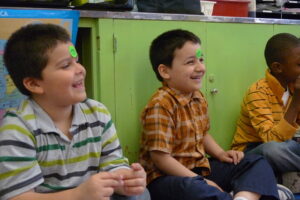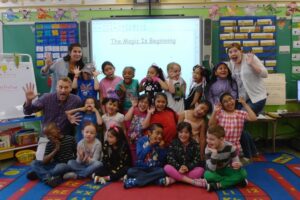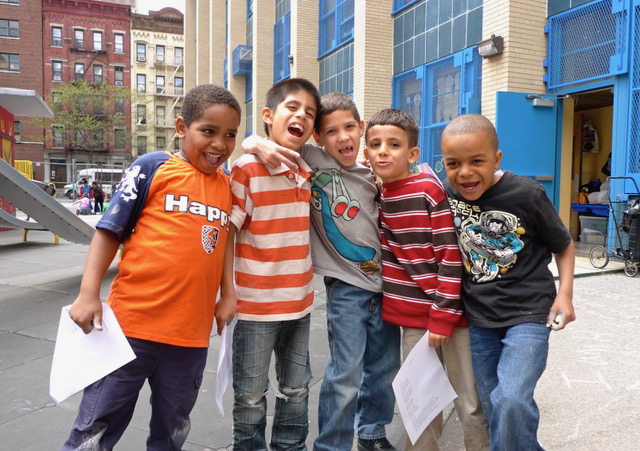“The best way to help children write freely is by
encouragement, by examples, and by various other
inspiring means.”
— Kenneth Koch, Wishes, Lies, and Dreams
“All children are artists. The problem is how to remain
an artist once he grows up.”
— Pablo Picasso
If you walk into a room full of first-graders and say, “I’m sorry I’m late. The sunrise ate me for breakfast,” most will look back at you with wide, smiling eyes, ready to hear what happens next. Some will raise their hands to tell you what they ate for breakfast, and if you ask Cheyenne what the waffle said to the syrup, she’ll personify a waffle on the spot. If you try the same line with a fifth-grade class, you can count on some skeptical squints and crossed arms. A few will inform you that you made it up, the sunrise doesn’t have a mouth, and excuse me, Mr. Burgess, but waffles don’t talk. You can see a similar transition in their drawings. Often the spontaneous gestures of the younger students stiffen into straight-edged skyscrapers and precisely traced comics, and many of the early elementary abstract expressionists pick up the idea that they don’t know how to draw after all.
Collaborative poems can help us write more freely by returning a sense of play to the process. Writing becomes a game, which alleviates the anxiety to “make it good.” The poem moves too quickly to be interrogated with a ready eraser, and as the fluttering page is passed into another’s hands, we learn to let go and be spontaneous. We experience the surprise of an unexpected turn of phrase, a flash of intelligence amid the word-romp. We get ideas from the gestures of our collaborators, and a sort of congenial one-upmanship sets in. We wander beyond our usual boundaries. We inspire each other.
I recently introduced “Question & Answer Partner Poems” to the third-graders at PS 153 in Harlem. As a lead-in to the lesson, we discuss the concept of “wacky hyperbole and poetic truth.” Since it was a wet Monday morning, I open by asking them about the familiar expression “It’s raining cats and dogs.” They are happy to explain the difference between the literal and the figurative meaning, and then I pose the question: Why is it more exciting to say it’s raining cats and dogs than, for instance, “It’s raining a lot.” Because we get to enjoy the crazy image of dogs and cats tumbling from the clouds, barking and meowing and causing a traffic jam on 145th Street. The speaker gets his point across with a splash. It’s not so much a lie as a poetic explanation that sets our imaginations in motion. We briefly talk about others (“I’m so hungry, I could eat a horse.” “The USA is a melting pot.”) before kick-starting our own collaborations.

The next step is to brainstorm some big questions. In Poetry Everywhere, Jack Collom and Sheryl Noethe provide an excellent list to get our heads spinning: “What’s outside the universe? What’s inside the color pink?” India raises her hand: “A flock of dancing flamingoes.” Once the room begins to buzz with possibilities, each poet writes his or her first question. The point isn’t to answer our partner’s questions correctly; instead, we should be imaginative with our responses, exaggerating wildly or writing whatever poetic line pops into our heads. I wait a minute until most eyes are up: “One… two… three… PASS.” The time constraint has a liberating effect; it encourages students to go with their first thoughts without second-guessing themselves or fretting over spelling. Soon, giggling sets in and you can see them read each other’s lines with fascinated attention. Now and then an outburst of laughter cracks through the quiet, and I try to keep them focused without reining in the fun. The pages are passed back-and-forth for approximately fifteen minutes, and then the poets read their collaborations aloud to each other.
Some of the poems veer into a silliness that falls flat after the fact, but throughout the stack there are glimmers of a deeper process at play. Crystal and Keyli riff off each other like two ten-year-old surrealists.
What is at the center of the Earth?
In the center of the Earth there is a tooth factory.
What do they do in the tooth factory?
They fix dogs’ teeth.
Are the dogs’ teeth sharp?
They are sharp like a whale’s teeth.
Do the dogs bite you a lot?
They bite, but not a lot.
Are they good dogs?
Half of the dogs are very bad.
Do you keep them in a different room from the
good dogs?
No, so that they get along.
I like the way they work together to move the poem forward. The questioner weaves a thematic thread through the piece, and the answerer avoids simple yes or no replies. The dreamy details are surprising and vivid, and it’s hard to imagine either poet writing this piece without the other’s influence.
Daisy and Xienna have similar success. They’re attached at the hip, so their rhythmic call-and-response doesn’t surprise me. But several of their details do:
What’s at the center of the world?
A girl who wants to swirl.
What’s at the bottom of the sea?
A bee who wants to catch me.
Where does the sea end?
It doesn’t. It bends.
Where is D.R.?
It is very far.
Where could I bow?
Up there in the clouds.
Why do things rhyme?
Because it is a crime.
When Xienna reads the line about the sea bending, an assistant teacher shoots me a look of shocked delight. The rest of the class is mesmerized by their rhyming skills, and the partners take their seats amidst enthusiastic applause.
Other collaborators are bound to experience some resistance. When Ms. Parks asks Keyshawn to partner with Jorge, I watch his shoulders shrug as he crosses the room. Jorge sits apart from the other students near the window, a short distance from the teacher’s desk.
Keyshawn opens with the first question:
What is the
end of time
and space?
It’s simple. It’s “e” for time
and space.
Can I punch the world?
Time and space would end.
Can I fly across the universe
in one second?
If you did, you’d be:
a. an alien, or
b. everything in space.
What objects can touch the sun?
If the sun was made of stains,
stainless steel would touch the sun.
No, Jorge.
These two poets prove to be a pretty dynamic duo after all. Keyshawn is frequently the first poet to finish an assignment; he follows instructions well and takes pleasure in “being done.” Jorge, on the other hand, has difficulty keeping his pencil on the page and regularly abandons a poem mid-sentence. In this collaboration, Keyshawn keeps Jorge on task by feeding him great questions and awaiting his replies, and Jorge surprises the entire class with his wit and wordplay. You can sense Keyshawn’s exasperation in the final line, but when I single out their collaboration at the end of class, he smiles broadly. The poem is a source of pride for both poets, and it gives me new ideas about how to help Jorge in the future.

A few days later I repeat the partner assignment in a poetry-writing class at Brooklyn College. Our list of big questions is noticeably different (“Is homosexuality genetic?” “Will there ever be an end to war?”) but we throw ourselves into the Q&A with childlike abandon. The same giggling, the same rapt attention when the page is passed. Some poets experiment with line breaks; others dangle an incomplete sentence for their partner to finish. When the page is full, I ask them to add a title before we read the collaborations aloud.
For homework, we take the collaboration a step further. The stack is collected, shuffled, and redistributed, and each poet receives another pair’s collaboration to create a new ten-line poem. Many variations are possible, but we limit ourselves to the words on the page, with permission to arrange them in any order and repeat as many as necessary. Rosemary Taveras wrote two:
Relampagos
The sky is sparkling,
instantaneously dangerous—
a repeated process that
travels from
the winks, smirks, cackles and stares
and runs through
electrical touches
until it arrives at our words
because words are what they are.
All of them dipped in honey and blue.
Shortage of Hue
Catchers of
dreams, our words
are what they are. They
hold grudges and spark our hearts.
Some are long and some are dipped
in honey and sugar made to be
instantaneously dangerous.
Their nets are blue
because Bob Ross
ran out of
every other color.
The first phase of this assignment encourages us to write more freely, while the second phase is an exercise in revision and compression. When we return to the workshop with the ten-line poems, each poet hears his or her words in new contexts. Another author’s selection and arrangement of our language from in-class drafts is an interesting form of response; we find out which lines hit a particular target. And the final work is a complex collaboration between three poets that can provoke discussions of authorship, ownership, and intertextuality.
I’ve tried many other collaborative assignments with terrific results. We write “instant Shakespearean sonnets” by sketching the rhyme scheme in the margin and swapping the paper until the final couplet’s complete. We do the same with sestinas and villanelles. We scissor our favorite poems line-by-line and toss the strips in a central pile; each poet picks six and constructs a new poem interweaving her own words with the “found language.” Recently I made up an exercise called “The Ekphrastic Lune Loop.” Each poet brings in a reproduction of a favorite painting or photograph; then we sit in a circle, pass the pictures to the left, and pen one lune in response to each image.
Collaborative poems help us to shed some of our seriousness, our fear of making mistakes, and our fixed ideas about how and what we write. When we practice playing well with others, we lighten up and open to other possibilities. Some of the poems may feel more like high-spirited experiments than original works of art, but in writing them we learn new ways to channel inspiration when it strikes.
This article was originally published in the Spring 2009 issue of Teachers & Writers Magazine.
Matthew Burgess is an Associate Professor at Brooklyn College. He is the author of eight children's books, most recently The Red Tin Box (Chronicle) and Sylvester’s Letter (ELB). Matthew has edited an anthology of visual art and writing titled Dream Closet: Meditations on Childhood Space (Secretary Press), as well as a collection of essays titled Spellbound: The Art of Teaching Poetry (T&W). More books are forthcoming, including: As Edward Imagined: A Story of Edward Gorey (Knopf, 2024), Words With Wings & Magic Things (Tundra, 2025), and Fireworks (Harper Collins, 2024). A poet-in-residence in New York City public schools since 2001, Matthew serves as a contributing editor of Teachers & Writers Magazine.



